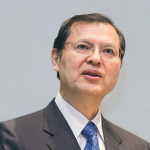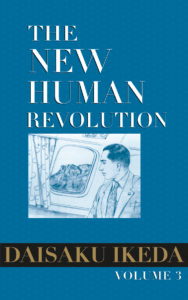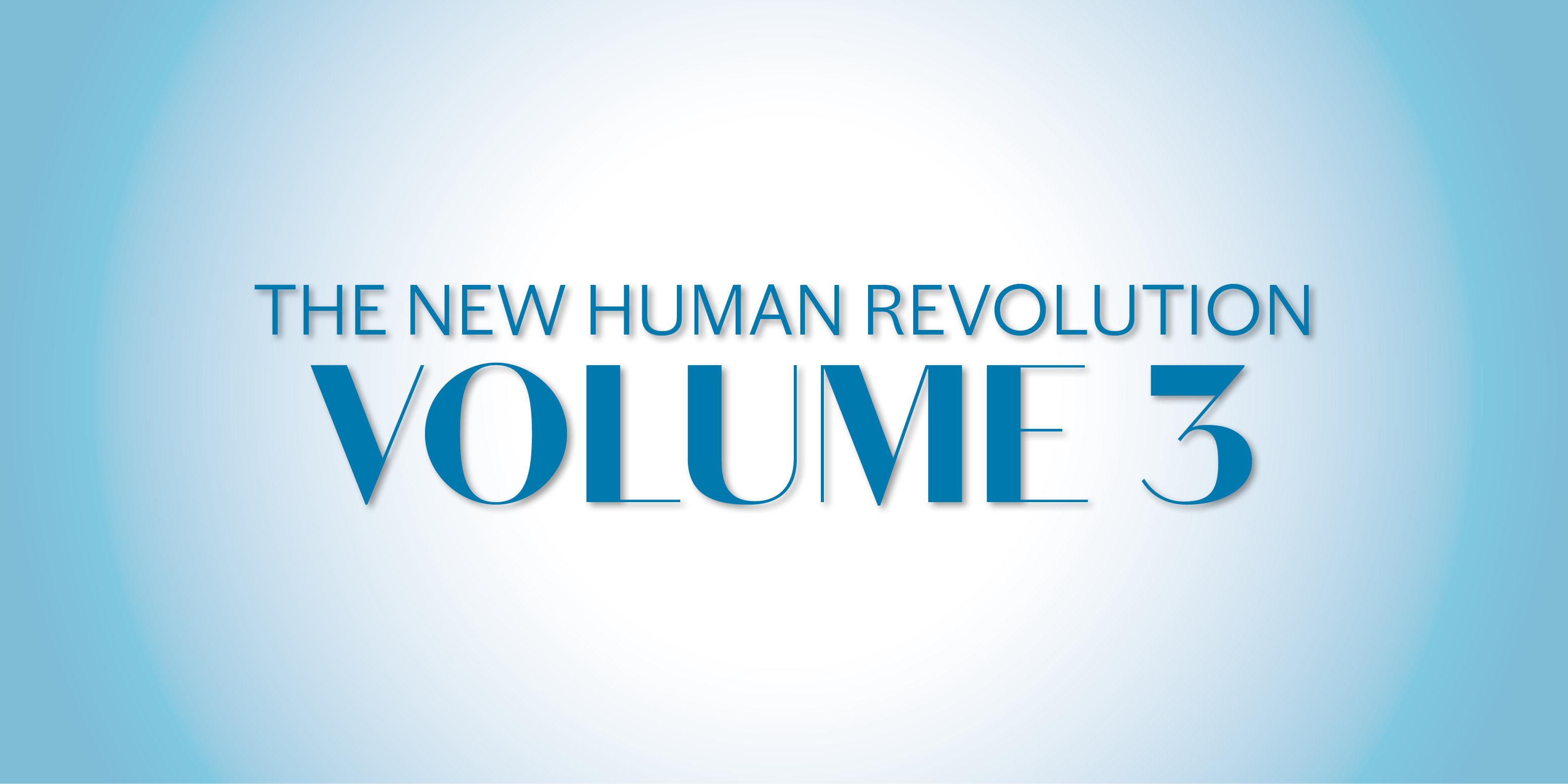 The realization of kosen-rufu in Asia was second Soka Gakkai President Josei Toda’s sincere determination, based on Nichiren Daishonin’s prophecy of the westward transmission of Buddhism.[1] President Toda entrusted it to Shin’ichi Yamamoto and his youthful successors. In studying volume 3 of The New Human Revolution, I would like to first confirm the meaning of this prophecy.
The realization of kosen-rufu in Asia was second Soka Gakkai President Josei Toda’s sincere determination, based on Nichiren Daishonin’s prophecy of the westward transmission of Buddhism.[1] President Toda entrusted it to Shin’ichi Yamamoto and his youthful successors. In studying volume 3 of The New Human Revolution, I would like to first confirm the meaning of this prophecy.
At the inaugural meeting of the young men’s division on July 11, 1951, President Toda declared:
Kosen-rufu is the mission that I absolutely must accomplish … We must spread the Great Pure Law [Nam-myoho-renge-kyo] not only to Korea, China and distant India, but to the farthest reaches of the Earth. This is what Nichiren Daishonin decrees.[2]
He also expressed his determination to realize kosen-rufu throughout Asia in the following poem:
To the people of Asia
who pray for a glimpse of the moon
through the parting clouds,
let us send them, instead,
the light of the sun.[3]
President Toda’s determination became Shin’ichi Yamamoto’s vow. Volume 3 describes how, 10 years after that inaugural young men’s division meeting, in January 1961, Shin’ichi departs for his first trip to Japan’s Asian neighbors, starting with Hong Kong and including Ceylon (present-day Sri Lanka), India, Burma (present-day Myanmar), Thailand and Cambodia. He states that his aim is “to take the first step toward Buddhism’s westward transmission prophesied by Nichiren Daishonin, thereby opening the path to happiness and lasting peace throughout Asia.”
On February 4, 1961, a ceremony is conducted at Bodhgaya[4] in India, where a plaque bearing the inscription “Kosen-rufu in Asia” and other items are buried. During the ceremony, President Toda’s poem echoes in Shin’ichi’s heart, and as he takes the first step toward kosen-rufu in the region, he makes the following pledge:
I’ll do it. I’ll do it no matter what … If I fall along the way, I’ll entrust its completion to the youth, whom I consider extensions of my own being. “Come forth, you Shin’ichi Yamamotos, in countless tens and hundreds of thousands!”[5]
In essence, the “Westward Transmission” chapter outlines the following progression:
1) Nichiren Daishonin predicts the westward transmission of Buddhism;
2) President Toda makes a vow to achieve kosen-rufu in Asia;
3) Shin’ichi inherits his mentor’s vow;
4) He entrusts its completion to countless thousands of youth.
Based on this, let us engrave in our hearts the fact that President Ikeda has entrusted us with the pro-found mission of realizing kosen-rufu in the new era.
Awakening to Our Mission as Bodhisattvas of the Earth
Volume 3 also explains how to understand the time—the opportune moment—for kosen-rufu. In the “India” chapter, Shin’ichi remarks:
Realizing the Daishonin’s prophecy hinges on the determination, powerful conviction and earnest action of those who come after him. As the Daishonin’s disciples, instead of waiting for his prediction to happen, shouldn’t we be determined to make it happen?[6]
Kosen-rufu will not come about if we simply wait for it. It is through the determination and action of disciples who have awakened to their mission as Bodhisattvas of the Earth that we can create the time for kosen-rufu.
Further, volume 3 explores the way to promote kosen-rufu. In the “Light of Peace” chapter, Shin’ichi describes this to the two Japanese members who welcomed him to Thailand, explaining that:
The Soka Gakkai’s efforts to disseminate Nichiren Daishonin’s teachings were neither backed by national powers nor promoted through the dispatch of missionaries. The Soka Gakkai’s propagation was based on the inner motivation of ordinary people who awoke to faith and stood up with a sense of mission in the communities or countries where they lived.[7]
Shin’ichi pours all his efforts into encouraging each member to rise up and embrace their mission. One such scene is depicted in his encouragement for Ikuyo Oka, a mother of three living in Hong Kong. Mrs. Oka’s husband (who had been transferred to Hong Kong by his company) was not a member. Shin’ichi tells her:
Actual proof, not theory, is most essential when trying to convince a family member to practice. Your personal growth and development are especially important in this respect.[8]
With his eyes focused on the future, Shin’ichi also encourages one of Mrs. Oka’s daughters to awaken to her mission: “You have come to Hong Kong not by chance—not simply because of your father’s transfer—but so that you may fulfill your mission for kosen-rufu.”[9]
Hong Kong, the first destination of Shin’ichi’s travels for peace in Asia in 1961, was also the last stop in his world travels in the 20th century (December 2000). The “Vow” chapter of volume 30 of The New Human Revolution also touches on this first visit to Hong Kong in 1961 and describes how a magnificent path for kosen-rufu in the 21st century had opened in Asia and the rest of the world. In the brief period of just 40 years, kosen-rufu in Hong Kong had advanced rapidly due to the strenuous efforts of the members who had made Shin’ichi’s heart their own.
The Soka Gakkai’s Fundamental Purpose
The “India” chapter refers to how the ancient Indian ruler King Ashoka (304–232 BCE) governed his empire. Shin’ichi contemplates the reason for King Ashoka’s decision not to make Buddhism a state religion:
I assume that, as a ruler, he wanted to protect freedom of thought and religion . . . King Ashoka must have wanted to prevent the outbreak of religious war.[10]
He further remarks, “The Soka Gakkai must be forever an organization that protects religious freedom.” In other words, the Soka Gakkai’s social mission is to resolutely fight against any oppression that violates the freedom of religion or other basic human rights, employing the power of dialogue to do so.
“The Buddha” chapter gives a detailed description of persecutions suffered by Shakyamuni, who continued to preach the Law till the very end, never submitting to the persecutions inflicted by the six non-Buddhist teachers[11] or to Devadatta’s betrayal.[12]
In light of this, the chapter clarifies that “bonds among those linked by faith are not based on self-interest; they are a joining of the human conscience based upon trust.”[13] The fabrication of scandals has been a common tactic employed by those who seek to destroy such bonds of trust. Some of the nine great ordeals or persecutions endured by Shakyamuni were also caused by fabricated scandals. Since ancient times, this has been a standard method of attacking people of justice, using base and false rumors in an attempt to discredit them.
Serialization of “The Buddha” chapter in the Seikyo Shimbun began in April 1995. Prior to this, that March, a fanatical religious group called Aum Shinrikyo (aka Aum Supreme Truth) had committed a deadly terrorist attack on the Tokyo subway system using sarin gas. Following this, there were widespread calls within Japanese society for stricter regulation of religious corporations, which later led to a revision of the Religious Corporation Law.
“The Buddha” chapter became a source of encouragement for the Soka Gakkai members who were troubled by the false rumors and criticisms that were circulating in the aftermath of this affair. In addition, I feel it was also intended to serve as a record of the typical traits of religious persecution, for the sake of posterity.
In the “Light of Peace” chapter, Shin’ichi states:
The religious mission of Buddhists is ultimately to fulfill their mission as human beings in society. Only a religion that enables people to do this may be called a “living religion.” Buddhism is not mere theory. Genuine religious faith enables the banner of human triumph to be raised amid the realities of this world.[14]
The Soka Gakkai’s fundamental purpose lies in realizing the Daishonin’s ideal of “establishing the correct teaching for the peace of the land,” the realization of social prosperity and peace for all humanity. Let us therefore joyfully engage in dialogue in the spirit of friendship as we create a network of happiness in our communities.
Translated from the December 26, 2018, issue of the Seikyo Shimbun, the Soka Gakkai’s daily newspaper.
Summary of Contents
 Westward Transmission
Westward Transmission
In January 1961, Shin’ichi Yamamoto departs for a tour of Asian countries. In Hong Kong, his first destination, he establishes the first district in Asia outside Japan.
India
On February 4, Shin’ichi visits Bodhgaya in India where Shakyamuni attained enlightenment, and buries a stone plaque dedicated to kosen-rufu in Asia.
Buddha
At Bodhgaya, Shin’ichi reflects on the noble life of Shakyamuni as an ordinary person.
Light of Peace
Shin’ichi visits Burma (present-day Myanmar) where his eldest brother lost his life in the war.
This book is available at https://bookstore.sgi-usa.org.
References
- Nichiren Daishonin predicted that Buddhism, which originally traveled from west to east (from India to China, Korea and Japan), will eventually return to India and spread throughout the world, in the same way that the sun rises in the east and moves westward. ↩︎
- The New Human Revolution, vol. 3, revised edition, p. 32. ↩︎
- Ibid., p. 138. ↩︎
- Historically known as the site where Shakyamuni attained enlightenment. ↩︎
- The New Human Revolution, vol. 3, revised edition, p. 139. ↩︎
- Ibid., p. 84. ↩︎
- Ibid., p. 279. ↩︎
- Ibid., p. 63. ↩︎
- Ibid., p. 58. ↩︎
- Ibid., pp. 107–08. ↩︎
- Influential thinkers in India during Shakyamuni’s time who openly broke with Vedic tradition and challenged Brahman authority in the Indian social order. Jealous of the growth of Shakyamuni’s following, they plotted schemes to oust him, marking the beginning of a lifetime of persecution. ↩︎
- A cousin of Shakyamuni who first followed him as a disciple but later became his enemy. He is described as a man of utmost evil who tried to kill Shakyamuni and disrupt his Order. ↩︎
- The New Human Revolution, vol. 3, revised edition, p. 185. ↩︎
- Ibid., p. 284. ↩︎
You are reading {{ meterCount }} of {{ meterMax }} free premium articles

